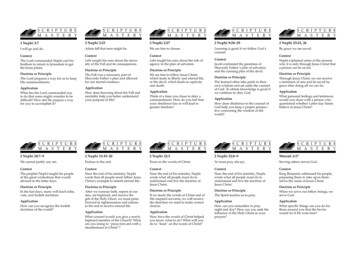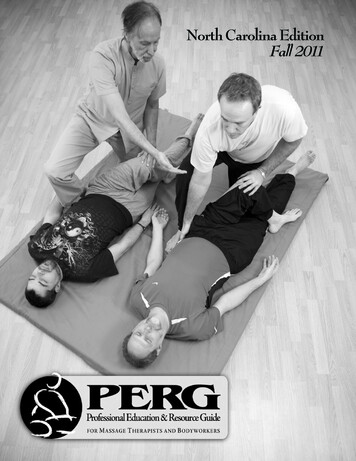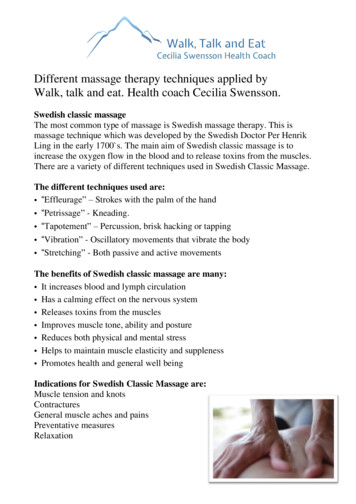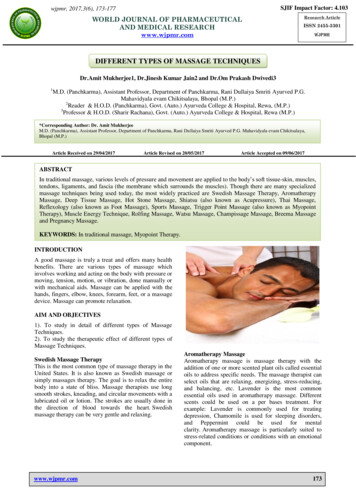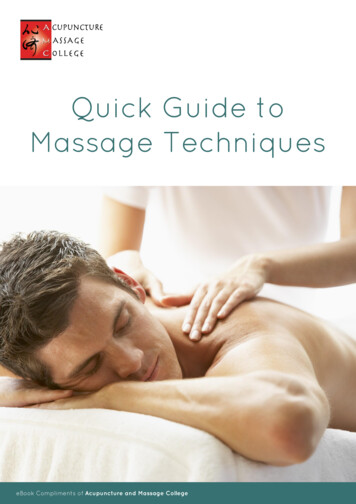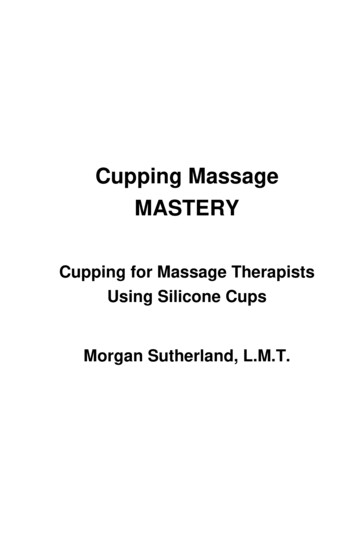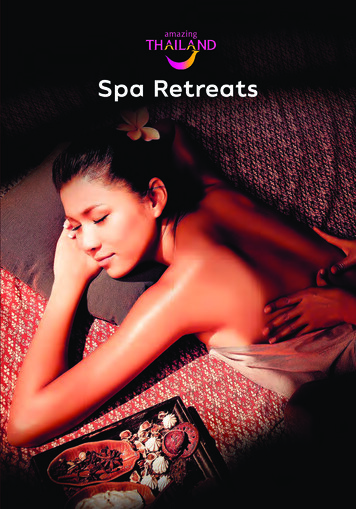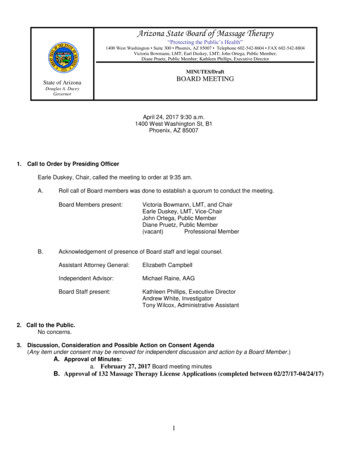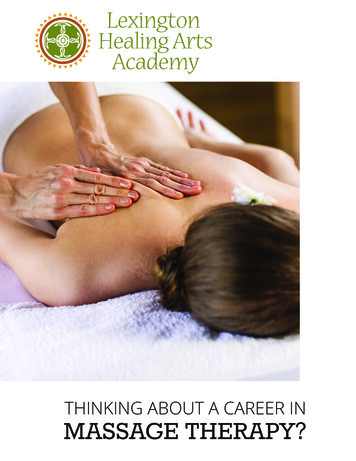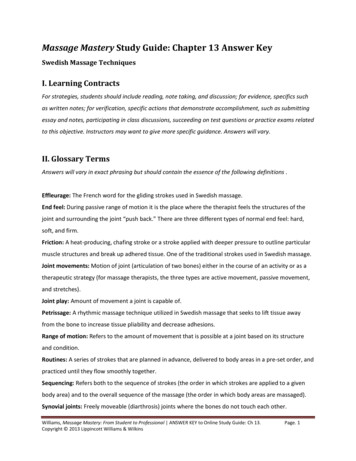
Transcription
Massage Mastery Study Guide: Chapter 13 Answer KeySwedish Massage TechniquesI. Learning ContractsFor strategies, students should include reading, note taking, and discussion; for evidence, specifics suchas written notes; for verification, specific actions that demonstrate accomplishment, such as submittingessay and notes, participating in class discussions, succeeding on test questions or practice exams relatedto this objective. Instructors may want to give more specific guidance. Answers will vary.II. Glossary TermsAnswers will vary in exact phrasing but should contain the essence of the following definitions .Effleurage: The French word for the gliding strokes used in Swedish massage.End feel: During passive range of motion it is the place where the therapist feels the structures of thejoint and surrounding the joint “push back.” There are three different types of normal end feel: hard,soft, and firm.Friction: A heat-producing, chafing stroke or a stroke applied with deeper pressure to outline particularmuscle structures and break up adhered tissue. One of the traditional strokes used in Swedish massage.Joint movements: Motion of joint (articulation of two bones) either in the course of an activity or as atherapeutic strategy (for massage therapists, the three types are active movement, passive movement,and stretches).Joint play: Amount of movement a joint is capable of.Petrissage: A rhythmic massage technique utilized in Swedish massage that seeks to lift tissue awayfrom the bone to increase tissue pliability and decrease adhesions.Range of motion: Refers to the amount of movement that is possible at a joint based on its structureand condition.Routines: A series of strokes that are planned in advance, delivered to body areas in a pre-set order, andpracticed until they flow smoothly together.Sequencing: Refers both to the sequence of strokes (the order in which strokes are applied to a givenbody area) and to the overall sequence of the massage (the order in which body areas are massaged).Synovial joints: Freely moveable (diarthrosis) joints where the bones do not touch each other.Williams, Massage Mastery: From Student to Professional ANSWER KEY to Online Study Guide: Ch 13.Copyright 2013 Lippincott Williams & WilkinsPage. 1
Tapotement: A rhythmic percussion stroke used in Swedish massage.Vibration: A pulsating, tremor-like, oscillating stroke practiced as part of Swedish massage.III. True or rueFalseTrueFalseFalseIV. Matching1.2.3.4.5.6.7.8.9.10.CHEAJFGBIDV. Sentence Completion1.2.3.4.5.6.7.8.9.10.retention (or buildup or dcongestionRoutinescontinuityWilliams, Massage Mastery: From Student to Professional ANSWER KEY to Online Study Guide: Ch 13.Copyright 2013 Lippincott Williams & WilkinsPage. 2
VI. Short Answer QuestionsAnswers will vary in exact phrasing but should contain the essence of the following short answers.Topic 13-1: EffleurageEffleurage is often the first applied to a body area to spread lubricant, warm the muscles in anticipationof deeper work, and assess the general condition of the client’s tissue.Topic 13-2: PetrissageWhen you run myofascial fibers through your fingers during a petrissage stroke, the stroke helps breakup adhesive bonds, makes the tissue more pliable, and gives the ground substance a good stirring.Topic 13-3: FrictionCross-fiber friction is applied across the fibers of the muscle instead of following the muscle fiberdirection. This rapid and deep transverse rubbing creates inflammation in the tissue, which stimulatestissue repair mechanisms and reorganizes connective tissue, leading to a breakdown of scar tissue thatmight otherwise restrict the client’s range of motion and lead to re-injury.Topic 13-4: VibrationIf a client demonstrates muscle guarding because of an injury, shaking and jostling are contraindicatedbecause this type of “splinting” of an area is appropriate to prevent further injury or pain.Topic 13-5: Tapotement1.Tapotement contraindicated over the kidneys and floating ribs is because these structures donot have sufficient protection and may be damaged by the stroke. It should also be avoided on boneyareas, especially over the spine, and over bruises and varicose veins.2.Tapotement should not be used directly after athletic activity because it stimulates the musclespindle cells and may cause the muscles to cramp.Topic 13-6: Joint MovementsIf the client has had surgical replacements or has surgical pins or plates in place to stabilize a joint, thejoint is likely more restricted. Joint movements may still be beneficial, but you will need to work moreslowly and with greater caution. Never force a joint or use high-velocity thrusting movements or fastbouncing movements that cause the muscles to go into a protective contraction.Topic 13-7: Putting It All Together1.Routines that are planned in advance can be delivered to body areas in a pre-set order flowingsmoothly together. Routines may include enhancing extras like the use of warm packs, aromatherapy,and foot soaks to increase the client’s sense of luxury and relaxation. Clients know beforehand what theWilliams, Massage Mastery: From Student to Professional ANSWER KEY to Online Study Guide: Ch 13.Copyright 2013 Lippincott Williams & WilkinsPage. 3
massage will be like and can count on receiving the same massage when they return for another session.When massage is used for relaxation, the predictable quality of a set routine adds to the client’s sense ofsafety and ability to unwind.2.The drawback to routines is that clients may not get the specific work they want or need fortheir particular areas of muscular tension, and the therapist may stop paying close attention to theindividual client.VII. Case StudiesAnswers will vary, but should generally be consistent with the following:Topic 13-6: Joint MovementsThe best thing is to explain the benefits of joint movements and how these complement and worktogether with the other benefits of massage. Explain that moving of joints is important for good health.Holding the body in fixed, unchanging positions for long periods of time causes muscles, tendons, andfascia to “learn” these new positions, resulting in tense and rigid soft tissue structures. Along withdiminished muscular movement comes decreased physical expression and diminished psychologicalexpression. Moving a joint is necessary for the synovial membrane to secrete synovial fluid and thehyaline cartilage to be lubricated and create new cells. Joint movement also helps lengthen tightmuscles and helps weak muscles regain their normal firing patterns to restore the muscular balancenecessary for normal joint play movements.Joint movement techniques encourage the movement of lymph, stimulate the production ofsynovial fluid to lubricate and nourish the joint, increase local circulation, stretch muscles and fascia, andhelp re-educate the body about its movement potential. These techniques help maintain or increase theclient’s flexibility, maintain normal joint play, reduce muscle guarding and thereby gain greaterkinesthetic awareness, increase relaxation, and improve muscular balance around the joint.Topic 13-7: Putting It All Together1. First, explain briefly why you began with effleurage and its benefits at the start of the session. Youmight say that you usually apply it first to a body area to spread lubricant, warm the muscles inanticipation of deeper work, and assess the general condition of the client’s tissue. Assure him that youwill soon move to deeper work, and you can apply the effleurage now more moderately or deeply andstill achieve these goals. Finally, encourage him next time to explain his preferences more fully in theintake interview, since this time he said he wanted a “typical” full-body massage.2. This situation is primarily an issue of therapeutic intention. While it is only normal for you to befeeling stress in these circumstances, it is your professional responsibility to not allow these negativefeelings to affect your therapeutic intent. Your client is no doubt feeling your lack of focus. Ideally, youshould have taken a moment before this massage session to center and ground yourself. By getting inthe moment, and focusing exclusively on the client and setting aside all thoughts about your own issues,you can regain a strong therapeutic intent focused on the client, who will then achieve a greaterrelaxation and better overall experience.Williams, Massage Mastery: From Student to Professional ANSWER KEY to Online Study Guide: Ch 13.Copyright 2013 Lippincott Williams & WilkinsPage. 4
VIII. ActivitiesEach student will have a unique set of answers.IX. RubricsLearning Objective13-1. List two physiologicaleffects from each of the sixSwedish massage techniquesdescribed.13-2. Compare and contrast theeffects of a friction stroke appliedbriskly and lightly with those of afriction stroke applied with slow,moderate pressure.13-3. Explain the different effectsof applying an effleurage stroke indifferent directions: away fromthe heart and towards the heart.13-4. Briefly explain the effect ofpetrissage on Golgi tendonorgans.13-5. Briefly explain the effect offriction on adhesions.13-6. Compare and contrastactive, passive, and resisted rangeof motion techniques.13-7. Describe the effects ofsubtle factors such as rhythm,depth, and pacing on the client’smassage experience.ExcellentThe student is able toaccurately list at least twophysiological effects fromeach of the six Swedishmassage techniques withas much detail as is givenin the chapter.The student is able toaccurately describe theeffects of a friction strokeapplied briskly and lightlyand those of a frictionstroke applied with slow,moderate pressure andthen compare andcontrast the two.The student can clearlyand correctly explain all ofthe effects of applying aneffleurage stroke awayfrom the heart andtowards the heart andcontrast the two.The student is able tothoroughly and accuratelyexplain the effect ofpetrissage on Golgi tendonorgans.The student is able tothoroughly and accuratelyexplain the effect offriction on adhesions.The student is able toaccurately describe theeffects of active, passive,and resisted range ofmotion techniques andthen compare andcontrast the two.The student can correctlyand in detail describe theeffects of subtle factorssuch as rhythm, depth,and pacing on the client’smassage experience,including examples.GoodThe student is able to listone or two physiologicaleffects from each of thesix Swedish massagetechniques, but is not ableto describe them in detail.Needs ImprovementThe student is not able to listone or two physiological effectsfrom each of the six Swedishmassage techniques.The student is able toarticulate some of theeffects of a friction strokeapplied briskly and lightlyand those of a frictionstroke applied with slow,moderate pressure, and isable to partially compareand contrast the two.The student can explain ingeneral the effects ofapplying an effleuragestroke away from theheart and towards theheart.The student is unable toaccurately define the effects ofeither a friction stroke appliedbriskly and lightly or those of afriction stroke applied with slow,moderate pressure, and cannotdescribe the differencesbetween the two.The student can explain ingeneral the effect ofpetrissage on Golgitendon organs.The student is unable to identifythe effect of petrissage on Golgitendon organs.The student can explain ingeneral the effect offriction on adhesions.The student is unable to identifythe effect of friction onadhesions.The student is able toarticulate some of theeffects of active, passive,and resisted range ofmotion techniques andcan partially compare andcontrast the two.The student can describein general the effects ofsubtle factors such asrhythm, depth, and pacingon the client’s massageexperience.The student is unable toaccurately describe active,passive, and resisted range ofmotion techniques and cannotadequately describe differencesamong them.The student is unable to explainany difference in the effects ofapplying an effleurage strokeaway from the heart andtowards the heart.The student is unable to identifythe effects of subtle factors suchas rhythm, depth, and pacing onthe client’s massage experience.Williams, Massage Mastery: From Student to Professional ANSWER KEY to Online Study Guide: Ch 13.Copyright 2013 Lippincott Williams & WilkinsPage. 5
Williams, Massage Mastery: From Student to Professional ANSWER KEY to Online Study Guide: Ch 13.Copyright 2013 Lippincott Williams & WilkinsPage. 6
Swedish massage techniques described. The student is able to accurately list at least two physiological effects from each of the six Swedish massage techniques with as much detail as is given in the chapter. The student is able to list one or two physiological effects from each of the six Swedish massage techniques, but is not able
